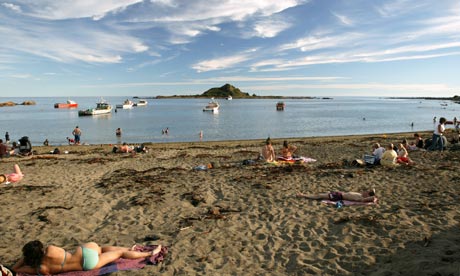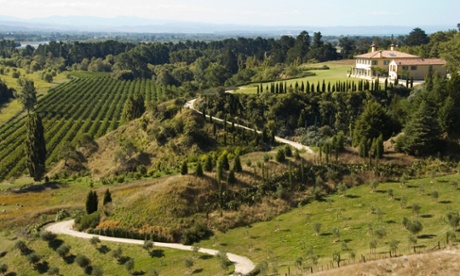From a distance, the building looks like a toddler’s birthday cake: bright, clashing colours crowned by a golden cupola that sparkles in the sun. Up close, its curvaceous form, detailed tile work and joyful colour choices are instantly recognisable as the work of the late Friedensreich Hundertwasser (1928-2000), the Austrian artist and “organic” architect whose social housing project, the Hundertwasserhaus, is one of Vienna’s most popular attractions.
Hundertwasser designed buildings in many countries across Europe, in California’s Napa Valley, in Israel, in Japan. But I’m not in any of those places. I’m on the other side of the world in Whangārei, a small regional city two hours’ drive north of Auckland in New Zealand.
Although he spent much of his later life in New Zealand, the Hundertwasser Art Centre is one of only two Hundertwasser buildings in the southern hemisphere. The other is a toilet block about 50km up the road.
Since I first visited Vienna in the early 1990s, I’ve been captivated by Hundertwasser’s distinctive work. As well as producing paintings, textiles, ceramics, objects and architectural designs, he was a radical thinker and prolific writer. He wrote passionate manifestos on a wide range of topics, from personal freedom to architecture, nature and even human waste.
In 1958’s Mouldiness Manifesto against Rationalism in Architecture he declared that “the straight line is godless and immoral” and he never moved away from this stance. Art critic and curator Robert Fleck described him as: “Manifestly one of the most strikingly visionary artists of the second half of the 20th century.”
When Hundertwasser’s toilet block in New Zealand’s Kawakawa opened in 1999, it put the tiny town on the tourism map. The project was the last completed in his lifetime. Famous for its curved lines, colourful tiles, bottle glass and grassed roof, it is the only public toilet I’ve ever visited where I was tempted to run my fingers across the walls or take off my shoes to feel the floors beneath my bare feet.
No doubt the city of Whangārei hopes the Hundertwasser Art Centre will draw crowds too. But it has had a bumpy start. The centre opened in February 2022, while New Zealand’s international borders were still closed to tourists.
Then, just when tourism was kicking back into gear, two devastating floods destroyed local roads, temporarily preventing access and generally discouraging visitors north. Beyond New Zealand, there has been little coverage of this major addition to the country’s architecture.
While the original plan for a Hundertwasser-designed art gallery in Whangārei was hatched decades ago, by the time the idea was finally approved, Hundertwasser had died.
So Joram Harel, the chairman of the Hundertwasser Foundation, suggested establishing the art centre to celebrate his legacy in New Zealand instead. The original 1993 Hundertwasser design, which has been faithfully followed, also includes the Wairau Māori Art Gallery, a contemporary art space that was integral to Hundertwasser’s vision.
Inside the centre, a winding staircase leads to a roof terrace where 150 trees and a total of 4,000 plants were used to create one of the largest green roofs in the southern hemisphere – Hundertwasser’s beloved “tree tenants”, designed to bring the forest into the city.
As well as the building itself, a Hundertwasser Foundation-curated exhibition celebrates his New Zealand work including paintings, textiles, architectural models as well as his popular Koru design for a secondary New Zealand flag. The 1972 documentary Hundertwassers Regentag (rainy day) captures the architect at work and contemplation in all his naked and bearded glory.
Like so much of his work and thinking about nature and human-shaped spaces, the colourful environmental protest posters Hundertwasser created in the 1970s feel acutely prescient.
Later this year, tourists will be able to gain an even more intimate view of Hundertwasser’s life when his Northland farm, Kaurinui, opens for guided tours.
It’s true critics haven’t always embraced Hundertwasser’s work. Harel writes that even the sound of his name could make other architects “see red”, but when asked if popular opinion on Hundertwasser has changed over the years, he dismisses the question: “Time caught up with his views, his visions, his manifestos and his engagement,” he says. “Hundertwasser’s life was his message.”










